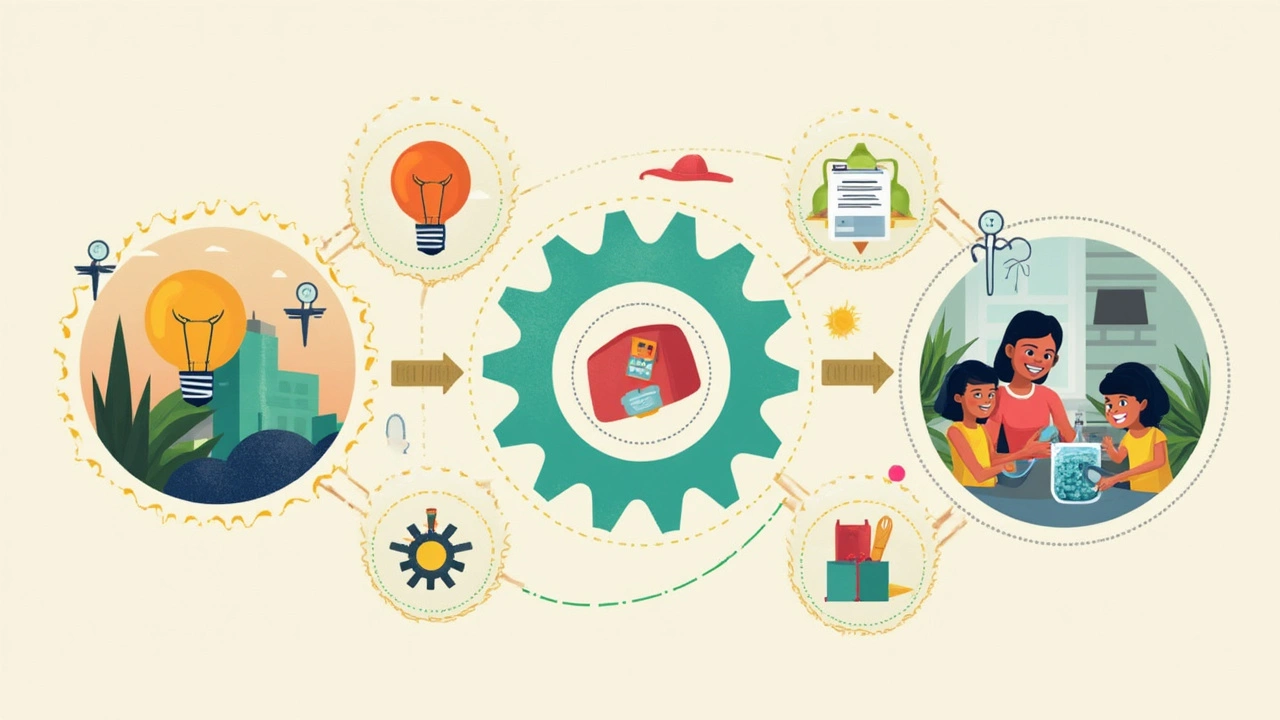Technology Transfer Programs: Turning Ideas into Reality
 Apr, 21 2025
Apr, 21 2025
When you hear “technology transfer program,” you might picture a group of researchers in white coats passing around secret blueprints. The reality is way more interesting, and you don’t need a lab coat to care about this process. These programs are all about moving clever ideas, like new phone features or smarter medical devices, out of dusty labs and into our daily lives.
Think of it like this: smart folks in universities, research centers, or even government labs invent something cool. But inventing is only half the game. Without a plan to get those inventions into real products, these breakthroughs would just collect dust. That’s where technology transfer programs come in—they’re like matchmakers, connecting inventors with companies or startups that know how to build and sell things.
If you’re wondering who runs these programs, it's usually universities, government agencies, and some private organizations. Want to know a quick tip? If you live near a big university or tech-focused institute, there’s almost always a tech transfer office that sits right in the middle of research and business. This is your go-to place if you’re curious about inventions in your backyard.
- What Are Technology Transfer Programs?
- How These Programs Actually Work
- Who Benefits From Tech Transfer?
- Real-World Examples That Might Surprise You
- How to Get Involved or Find Tech Transfer Opportunities
What Are Technology Transfer Programs?
If you’re wondering how stuff made in research labs ends up hitting store shelves, technology transfer programs are the answer. These programs are like middlemen, but much friendlier than your usual sales guys. Their main goal? To help useful stuff get out of notebooks and into the real world, where it can actually make a difference.
Most technology transfer starts at big universities, hospitals, or government labs. When researchers discover new tech—maybe a cool new battery or a better drug—these programs step in to help protect the idea (think patents) and hunt for businesses who can make something people can use. They deal with paperwork, contracts, and lots of lawyer-speak so inventors can focus on inventing.
The whole process aims to:
- Move discoveries (innovation) from labs to industry
- Secure intellectual property (like patents)
- Find licensees—a fancy word for companies willing to pay to use the new tech
- Help inventors launch new startups
It’s more important than it sounds. According to AUTM (the group that tracks this stuff), U.S. universities alone secured over 7,500 licenses and options with companies in 2023. That means thousands of new products and jobs, just in one year.
| Year | Licenses/Options (US Universities) |
|---|---|
| 2021 | 6,950 |
| 2022 | 7,230 |
| 2023 | 7,565 |
But it’s not just about profits or shiny gadgets. Technology transfer helps boost the local economy and even gives students a peek at real-world business. Some colleges encourage students to join tech transfer teams, which is awesome if you like both science and entrepreneurship.
Bottom line: If you see a cool new phone feature, a life-saving drug, or cleaner energy tech, there’s a good chance a technology transfer program helped make it happen.
How These Programs Actually Work
So what does a technology transfer program do all day? Honestly, it’s a lot more hands-on than most people think. The process is kind of like a tag team match between researchers and business pros, with a few legal experts in the corner.
Here’s the usual play-by-play:
- Discovery: A scientist, engineer, or innovator comes up with something new—maybe a way to speed up Wi-Fi or a better vaccine delivery method. This is often funded by universities, government grants, or big research projects.
- Disclosure: The inventor fills out a formal invention report. This gets sent to the program’s tech transfer office so the idea doesn’t vanish into thin air.
- Evaluation: The tech transfer team digs in, looking at questions like: “Will anyone actually use this?” and “Is someone else already doing this?”
- Protection: If the idea looks promising, they file patents or copyrights. Tech transfer folks know their way around legal paperwork, which keeps copycats at bay.
- Marketing: Now someone in the office hunts for companies, investors, or entrepreneurs who’d want this new tech. They write up quick summaries and pitch the invention like it’s the next big trend.
- Licensing or Startup Launch: If there’s a taker, the rights to use the invention are sold or licensed. Sometimes, the original researcher even helps launch a startup to build it out.
- Development: The company (or sometimes a new company) takes the lead, turning the invention into a product you can actually buy, whether that’s a new phone app or eco-friendly plastic.
Here’s a quick table just to give some real numbers. For example, the Association of University Technology Managers (AUTM) shared that U.S. universities filed over 25,000 new invention disclosures and signed nearly 7,500 licenses or options in 2022:
| Step | U.S. University Activity (2022) |
|---|---|
| Invention Disclosures | 25,500+ |
| Licenses/Options | 7,500 |
| Startups Formed | 1,500+ |
All this starts local—usually on campus—but has a real shot at becoming global. That’s how stuff invented in a tiny university lab can end up changing your day-to-day life.

Who Benefits From Tech Transfer?
It’s not just big tech companies or cool startups who win from technology transfer programs. The reach is way broader, and you might actually feel the impact without even realizing it. Let’s break down who really gets something out of these programs.
- Researchers & Universities: They get recognition and sometimes money for their discoveries. When a university invention turns into a commercial product, the inventor and their school often split any earnings. For example, the University of Florida has made millions from the invention of Gatorade, which started as a campus research project.
- Businesses & Startups: These folks jump in, license new tech, and turn it into stuff people want—like new medicines, phone apps, solar panels, and car gadgets. It can help startups stand out, especially if they’re using tech that bigger companies don’t have yet.
- Government & Military: Agencies like NASA and the Department of Energy see their research actually help citizens by making its way into things like memory foam, water filters, and better batteries.
- Consumers (Yep, You): Maybe you’re reading this on a touchscreen, or you’ve used GPS today. Both of those were once locked away in government-funded labs and are now everyday gear thanks to technology transfer programs. You get access to smarter, safer, and sometimes cheaper products.
Here’s a quick look at the typical impact:
| Who | How They Benefit |
|---|---|
| Universities | Royalties, research support, reputation boost |
| Startups | Exclusive tech, quicker product launch, investor interest |
| Government | Public good, economic growth, national security advances |
| Everyday People | Cooler, safer, and sometimes more affordable tech |
So, if you’re part of a research group, run a business, work in government, or just enjoy new things, you’re probably already reaping the rewards of technology transfer without noticing it. Sounds like a win all around, right?
Real-World Examples That Might Surprise You
Some stuff you use every day actually started in a lab and made its way out thanks to technology transfer programs. Let’s break down a few cases you probably didn’t expect.
Ever used Google Maps or checked the weather on your phone? That’s built on GPS, a system invented by the U.S. military. Through technology transfer, civilian companies got access, leading to everything from food delivery tracking to running apps.
Here’s another one: the USB port. It started as a simple idea in Intel’s labs to make connecting devices easier. Once the design was shared and licensed, loads of tech companies picked it up. Now, it’s tough to find a gadget that doesn’t have a USB port.
If you or someone you know has diabetes, there’s a good chance they benefit from technology that came from university research. The first continuous glucose monitor came from a university lab. The school worked with medical device startups through a technology transfer program, getting it FDA-approved and into the hands of patients fast.
NASA is a giant in this space. Since the '60s, they’ve licensed technology to companies in categories you might never guess. Memory foam mattresses? That bouncy material was made to keep astronauts comfy during launch. Water filters for hikers and campers? That came from systems built for the space shuttle.
Some real-world transfer stats might surprise you even more. Check this out:
| Source | Technology | Everyday Use |
|---|---|---|
| NASA | Infrared Ear Thermometer | Quick fevers checks for kids at home |
| Stanford University | Google Search Algorithm | The backbone of the world’s most popular search engine |
| US Department of Defense | Internet (ARPANET) | Worldwide communication and business |
Here’s a tip if you’re building a startup: Many universities and agencies publish a public list of inventions for license, from battery tech to biotech. You can often reach out to their technology transfer office and set up a meeting—sometimes even without being a student or staff member!

How to Get Involved or Find Tech Transfer Opportunities
So, you want to plug into this world of technology transfer? It’s easier than most people think, and you don’t have to be a scientist or a suit-and-tie executive to take part. Whether you’re an entrepreneur, a curious student, or just love tech, there’s a way in.
First, check if your local university or college has a tech transfer office. Most major research schools, like MIT, Stanford, and IIT Delhi, have official departments that connect inventions with businesses. These offices hold events, info sessions, and workshops—many are open to the public. Just Google “[university name] technology transfer office” to find a contact.
If you’re already working at a company, ask about partnerships with universities or government labs. Big firms like IBM, Google, and Medtronic regularly scout for cool tech via these programs. They even run joint events and startup competitions where you can pitch ideas or find a team.
Looking to launch a startup around new tech? The U.S. has a searchable database called Federal Lab Consortium where you can browse inventions and get in touch with inventors. Across Europe, the CORDIS portal offers listings from EU-funded research, making it super easy to spot open opportunities.
Here’s a quick set of steps for getting started:
- Find your local or regional technology transfer office online.
- Sign up for their newsletter or alerts on upcoming info sessions.
- Attend free workshops or “demo days” to see what’s being invented.
- Network with university staff and startup founders. Ask questions—lots of them.
- Review available tech in online databases like AUTM Innovation Marketplace, FLC, or CORDIS.
Wonder what kinds of opportunities are out there? Here’s a quick peek at data from 2023 about technology transfer deals, just to give you a sense of the scale:
| Country | Deals Completed | Startup Licenses Issued |
|---|---|---|
| United States | 7,900+ | 1,120 |
| India | 850+ | 210 |
| UK | 600+ | 195 |
The world of technology transfer programs is open—sometimes all it takes is one email or event visit to spark something big.